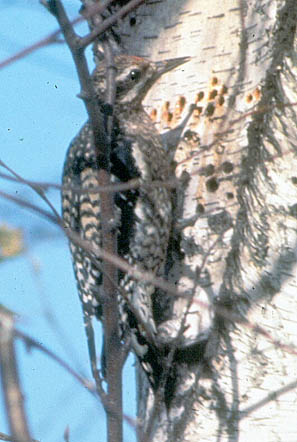Yellow-bellied Sapsucker | |
|---|---|
| September 18, 2008 | |
|
Yellow-bellied sapsuckers attack Illinois trees during both spring and fall migrations through the state. These woodpeckers typically fly south through Illinois from about mid-September through October, and they fly back north in the spring from early April through mid-May. These starling-sized black-and-white birds typically drill holes (1/4 inch in diameter) in vertical or horizontal rows in the predawn hours. They then feed on the sap as it runs out of the holes. They also feed on insects that are attracted to the sap, but much of their diet consists of tree sap. In Illinois, these holes are unlikely to damage the health of the tree because the birds are in the state for only a short time. In the far southern United States as well as the far northern United States and southern Canada, where the birds spend the winter and summer, individual trees may be killed from continual drilling and feeding. Trees most often attacked in Illinois are Scotch pine, Austrian pine, and white-barked birches, although many other species are attacked occasionally. Large amounts of sap may run out of the holes made in pine trees, congealing and turning white on the trunk. Although this looks impressive, it appears to have little or no effect on tree health. Because there is no apparent effect on tree health in Illinois, a viable option is to do nothing. If you want to protect individual trees while the birds are flying through, wrap tree wrap around attacked trunks. Remove the wrap when the migration time has passed; otherwise, moisture underneath the wrap may promote disease. Inflatable owls or snakes may also be effective, as will lengths of garden hose that resemble snakes. For the owls and snakes to be effective, they must be moved almost daily. It is thought that the same bird attacks the same tree each year as it migrates through the area. Thus, a bird watching a tree notices that the owls or snakes havenít moved for several days and concludes they must be dead. The association of individual birds and specific trees also explains why only certain trees are attacked while nearby trees of the same species are unharmed. Remember that yellow-bellied sapsuckers are protected by state and federal laws as well as international treaty, making it illegal to harm or kill the birds. | |
| Author: | Phil Nixon |

